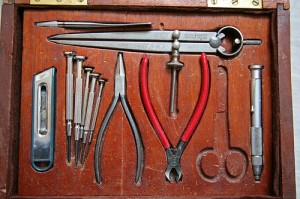Part of being resilient in the outer world is learning to be resilient in our inner worlds. If we
 don’t have a solid concept of who we really are inside, then it is much more likely that events happening outside are going to rock both our inner and outer worlds, and not in a good way.
don’t have a solid concept of who we really are inside, then it is much more likely that events happening outside are going to rock both our inner and outer worlds, and not in a good way.
With that in mind, I want to present some thoughts from two women I admire greatly: writer Anne Lamott and shame researcher Brene Brown.
I first shared these words from Anne Lamott in a previous post called Becoming the person you were meant to be:
We begin to find and become ourselves when we notice how we are already found, already truly, entirely, wildly, messily, marvelously who we were born to be. The only problem is that there is also so much other stuff, typically fixations with how people perceive us, how to get more of the things that we think will make us happy, and with keeping our weight down. So the real issue is how do we gently stop being who we aren’t? (My emphases.)
And here are some thoughts from Brene Brown’s book The Gifts of Imperfection: Let Go of Who You Think You’re Supposed to Be and Embrace Who You Are.
When we spend a lifetime trying to distance ourselves from the parts of our lives that don’t fit with who we think we’re supposed to be, we stand outside of our story and hustle for our worthiness by constantly performing, perfecting, pleasing, and proving. (p.23)
Authenticity is the daily practice of letting go of who we think we’re supposed to be and embracing who we are.
Choosing authenticity means
- cultivating the courage to be imperfect, to set boundaries, and to allow ourselves to be vulnerable;
- exercising the compassion that comes from knowing that we are all made of strength and struggle; and
- nurturing the connection and sense of belonging that can only happen when we believe that we are enough.
Authenticity demands Wholehearted living and loving – even when it’s hard, even when we’re wrestling with the shame and fear of not being good enough, and especially when the joy is so intense that we’re afraid to let ourselves feel it.
Mindfully practicing authenticity during our most soul-searching struggles is how we invite grace, joy, and gratitude into our lives. (p.50)
Takeaway points: Even though we are so often encouraged to be someone we aren’t, only cultivating the courage to be our true selves allows us to live freely and authentically – a good recipe for resilience.
I know I sometimes struggle with authenticity and feel the pressure to be someone other than my true self. How about you?
Brown, Brene. The Gifts of Imperfection: Let Go of Who You Think You’re Supposed to Be and Embrace Who You Are. 2010. Hazelden; Minnesota.






 crosswords are often built on puns within the clues or the theme of the puzzle. For example, the theme of last night’s crossword was “The Other Half.” The trick is to figure out the long answers in the puzzle that reflect the theme so you can more easily solve the puzzle. So, one of the clues was “Classic doll.” I filled in enough of the other answers to see the beginning of the long one was “Raggedy _ _ _ _.” Raggedy Ann? No, there were four spaces left. Raggedy Andy? Well, the ‘A’ worked, but not the rest of the letters. I paused and looked at the theme, “The Other Half.”
crosswords are often built on puns within the clues or the theme of the puzzle. For example, the theme of last night’s crossword was “The Other Half.” The trick is to figure out the long answers in the puzzle that reflect the theme so you can more easily solve the puzzle. So, one of the clues was “Classic doll.” I filled in enough of the other answers to see the beginning of the long one was “Raggedy _ _ _ _.” Raggedy Ann? No, there were four spaces left. Raggedy Andy? Well, the ‘A’ worked, but not the rest of the letters. I paused and looked at the theme, “The Other Half.”